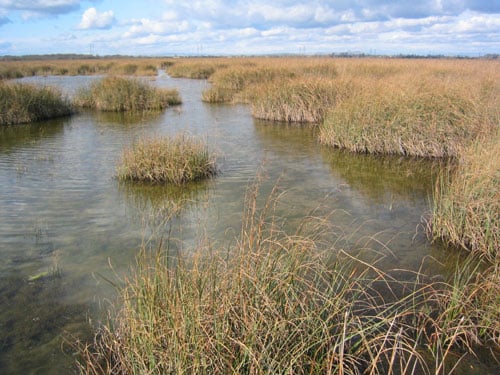Marshland is covered with grasses, reeds, sedges, and cattails. These plants all have their roots in soil covered or saturated with water and its leaves held above water. Marshes may be freshwater or salt. Freshwater marshes develop along the shallow edges of lakes and slow-moving rivers, forming when ponds and lakes become filled with sediment. Salt marshes occur on coastal tidal flats. Inland salt marshes occupy the edges of lakes. They affect the supply of nutrients, the movement of water, and the type and deposition of sediment.
Salt marshes are best developed on the Atlantic coasts of North America and Europe. In eastern North America the low marsh is dominated by  a single species, salt- marsh cordgrass. The high marsh consists of a short cordgrass called hay, spike grass, and glasswort. Glasswort is the dominant plant of Pacific Coast salt marshes.
a single species, salt- marsh cordgrass. The high marsh consists of a short cordgrass called hay, spike grass, and glasswort. Glasswort is the dominant plant of Pacific Coast salt marshes.
Freshwater marshes provide nesting and wintering habitats for waterfowl and shorebirds, muskrats, frogs, and many aquatic insects. Salt marshes are wintering grounds for snow geese and ducks, a nesting habitat for herons and rails, and a source of nutrients for estuarine waters. Marshes are important in flood control, in sustaining high- water tables, and as settling basins to reduce pollution downstream. Despite their great environmental value, marshes are continually being destroyed by drainage and filling.
Marine Life, plants and animals of the sea, from the high-tide mark along the shore to the depths of the ocean. These organisms fall into three major groups: the benthos, plants such as kelp and animals such as brittle stars that live on or depend on the bottom; the nekton, swimming animals such as fishes and whales that move independently of water currents; and plankton, various small to microscopic organisms that are carried along by the currents.
Shore Life, the essentially marine organisms that inhabit the region bounded on one side by the height of the extreme high tide and on the other by the height of the extreme low tide. Within these boundaries organisms face a severe environment imposed by the rise and fall of tides. For up to half of a 24-hour period, the environment is marine; the rest of the time it is exposed, with terrestrial extremes in temperature and the drying effects of wind and sun.
Life on rocky shores, best developed on northern coasts, is separated into distinct zones that reflect the length of time each zone is exposed. At the highest position on the rocks is the black zone, marked by blue-green algae. This transition area between land and the marine environment is flooded only during the high spring. Below the black zone lies the white zone, where barnacles are tightly glued to rocks. Living among the barnacles are rock-clinging mollusks called limpets. At low tide, barnacles keep their four movable plates closed to avoid drying; at high tide they open the plates and extend six pairs of wandlike tentacles to sweep the water for microscopic life. Preying on the barnacles are hole-drilling snails called dog whelks.
Below the white zone and in some places overlying the barnacles are rockweeds, which have no roots but attach themselves to rocks by holdfasts. Brown algae are rockweeds that grow more than 8 ft long. The most common are the bladder wracks, with branching thalli up to 6 in wide. In the lowest zone, uncovered only during the spring tides, is the large brown alga Laminaria, one of the kelps. Beneath its frondlike thalli live starfish, sea cucumbers, limpets, mussels, and crabs. On the sandy shores, life lies hidden beneath the surface, waiting for the next high tide. Shifting and unstable, sand provides no substrate on which life can anchor itself. The environment of sand-dwelling animals, however, is less severe than that of animals dwelling on rocky shores. Although the surface temperature on a beach varies with the tide, below the surface the temperature remains nearly constant, as does the salinity. The upper sandy beach, like the upper rocky shore, is transitional from land to sea. It is occupied by ghost crabs and beach fleas, animals more terrestrial than marine. True marine life appears at the intertidal zone. Two common inhabitants, active at high tide, are the lugworm, which burrows through the sand and feeds on organic matter; and the coquina clam Donax, which advances up the beach and retreats with the tides. Among the sand grains live small copepods and worms that feed on microscopic algae, bacteria, and organic matter. On the lower beach, which remains uncovered for only a short period of time, live clams, crabs, starfish, and sand dollars, whose calcareous skeletons lie partially buried in the sand.
